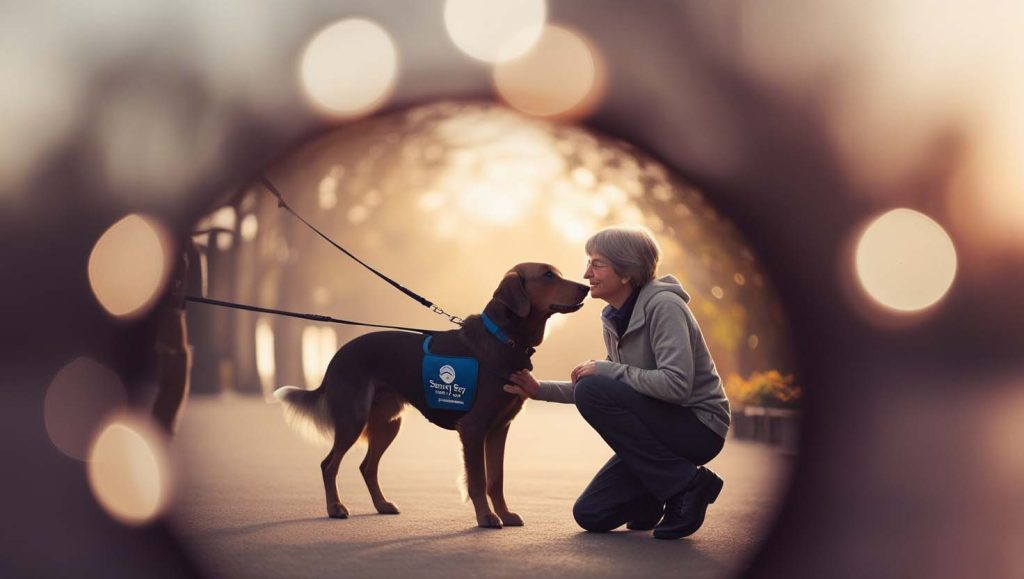The Seeing Eye has been a beacon of hope for individuals with visual impairments, providing expertly trained guide dogs to enhance independence, safety, and companionship. With a mission to empower people through mobility, The Seeing Eye has set the standard for guide dog training and partnerships. In this article, we’ll explore the history, training process, and life-changing impact of The Seeing Eye program.
What Is The Seeing Eye?
The Seeing Eye is the oldest guide dog school in the United States. Established in 1929, the organization has matched thousands of individuals with guide dogs, transforming their lives by providing freedom and mobility.
A Legacy of Leadership
Founded by Morris Frank and Dorothy Harrison Eustis, The Seeing Eye introduced the concept of guide dogs to America. Their innovative approach has since paved the way for other guide dog programs worldwide.
A Mission to Empower
The Seeing Eye’s mission is to train guide dogs and provide visually impaired individuals with the tools to navigate the world confidently. These partnerships go beyond mobility—they create lifelong bonds based on trust and understanding.
The Training Process at The Seeing Eye
The journey of a Seeing Eye dog begins at birth and continues through specialized training until they are ready to assist their handler. This rigorous process ensures each dog is well-prepared for its vital role.
Step 1: Puppy Raising and Socialization
From eight weeks old, Seeing Eye puppies are placed with volunteer families who raise them in a nurturing environment. During this phase, puppies learn basic commands, socialization skills, and how to behave in public spaces.
Key Activities in Puppy Raising:
- Exposure to different sounds, people, and environments.
- Learning obedience basics like “sit,” “stay,” and “heel.”
- Building confidence through consistent, positive experiences.
Step 2: Formal Guide Dog Training
At around 14-16 months, puppies return to The Seeing Eye for formal training. Skilled instructors teach them to:
- Navigate Obstacles: Guide their handler safely through crowded streets and complex environments.
- Intelligent Disobedience: Disobey commands when following them could result in danger.
- Street Safety: Recognize and respond to traffic signals, curbs, and moving vehicles.
Step 3: Matching Dogs with Handlers
Matching a guide dog with a handler is a detailed process. Factors such as personality, lifestyle, and walking pace are considered to ensure compatibility. Once matched, the handler and dog complete an intensive 3-4 week training program together.

The Life-Changing Impact of The Seeing Eye
The Seeing Eye program is more than just a guide dog school; it’s a transformative service that changes lives. The impact on handlers is both practical and emotional.
Gaining Independence and Mobility
Guide dogs enable visually impaired individuals to navigate the world with confidence. Whether traveling to work, running errands, or exploring new places, these dogs serve as reliable partners.
Strengthening Emotional Well-Being
Guide dogs provide companionship and emotional support, reducing feelings of isolation. The bond between the dog and handler offers comfort, security, and friendship.
Promoting Community and Connection
Handlers often report that their guide dog helps them engage more with their community. People feel more comfortable approaching someone with a guide dog, fostering social interactions.
Why The Seeing Eye Stands Out
The Seeing Eye remains a leader in guide dog training and education, setting the gold standard for excellence.
Decades of Expertise
With over 90 years of experience, The Seeing Eye continues to innovate and refine its training methods, ensuring that each dog meets the highest standards of performance.
Lifelong Support
The Seeing Eye provides ongoing support to handlers, ensuring they have the resources they need to care for their guide dog. This includes follow-up visits, training refreshers, and advice on health and care.
Commitment to Accessibility
The Seeing Eye works tirelessly to ensure accessibility and awareness. They advocate for the rights of individuals with guide dogs, promoting inclusivity in public spaces.
Frequently Asked Questions About The Seeing Eye
What breeds does The Seeing Eye use for guide dogs?
The Seeing Eye primarily uses Labrador Retrievers, Golden Retrievers, and German Shepherds due to their intelligence, temperament, and adaptability.
How long does it take to train a Seeing Eye dog?
It takes approximately 18-24 months, including puppy raising and formal guide dog training.
Are Seeing Eye dogs allowed in public places?
Yes, under the Americans with Disabilities Act (ADA), Seeing Eye dogs have the right to accompany their handlers in public places, including restaurants, stores, and transportation.
How does The Seeing Eye match dogs with handlers?
The organization carefully considers lifestyle, walking pace, personality, and individual needs to ensure the perfect match between dog and handler.
What happens when a Seeing Eye dog retires?
Retired guide dogs are often adopted by their handlers or placed with loving families to enjoy a well-deserved rest.
How can I support The Seeing Eye?
You can donate, volunteer as a puppy raiser, or advocate for guide dog accessibility and inclusion.
How to Support The Seeing Eye
Supporting The Seeing Eye helps ensure that visually impaired individuals can continue to benefit from these life-changing partnerships.
Donate to The Cause
Financial contributions fund the training, care, and placement of Seeing Eye dogs. Your donation directly impacts the lives of handlers and their guide dogs.
Volunteer as a Puppy Raiser
Puppy raisers play a critical role in shaping future guide dogs. By providing early socialization and training, you help prepare puppies for their important work.
Advocate for Guide Dog Accessibility
Spread awareness about the rights of individuals with guide dogs. Encourage businesses and public spaces to create inclusive, welcoming environments.


